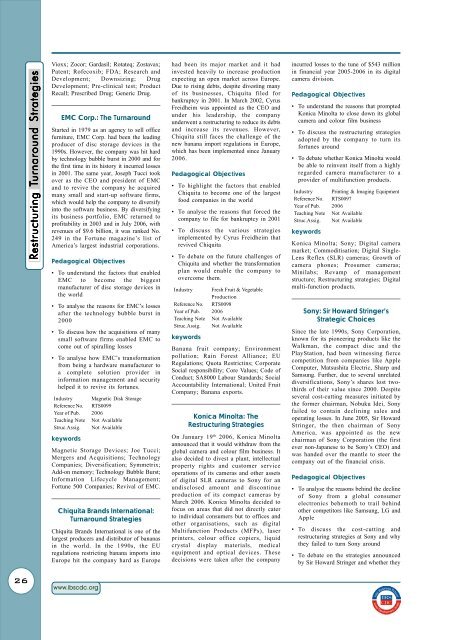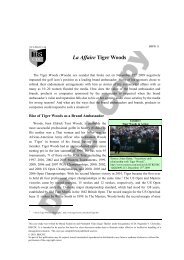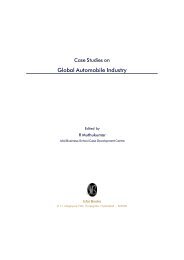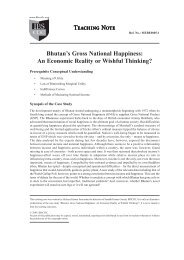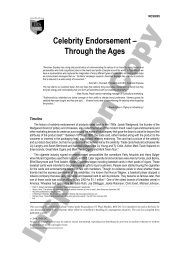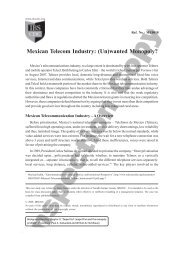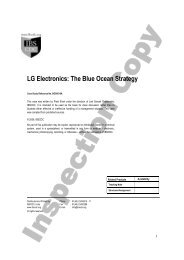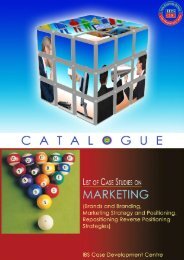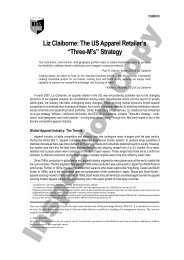List of Case Studies on Strategy - Case Catalogue IV
List of Case Studies on Strategy - Case Catalogue IV
List of Case Studies on Strategy - Case Catalogue IV
You also want an ePaper? Increase the reach of your titles
YUMPU automatically turns print PDFs into web optimized ePapers that Google loves.
26<br />
Restructuring estructuring T TTurnaround<br />
T urnaround Strategies<br />
Strategies<br />
Vioxx; Zocor; Gardasil; Rotateq; Zostavax;<br />
Patent; R<str<strong>on</strong>g>of</str<strong>on</strong>g>ecoxib; FDA; Research and<br />
Development; Downsizing; Drug<br />
Development; Pre-clinical test; Product<br />
Recall; Prescribed Drug; Generic Drug.<br />
EMC Corp.: The Turnaround<br />
Started in 1979 as an agency to sell <str<strong>on</strong>g>of</str<strong>on</strong>g>fice<br />
furniture, EMC Corp. had been the leading<br />
producer <str<strong>on</strong>g>of</str<strong>on</strong>g> disc storage devices in the<br />
1990s. However, the company was hit hard<br />
by technology bubble burst in 2000 and for<br />
the first time in its history it incurred losses<br />
in 2001. The same year, Joseph Tucci took<br />
over as the CEO and president <str<strong>on</strong>g>of</str<strong>on</strong>g> EMC<br />
and to revive the company he acquired<br />
many small and start-up s<str<strong>on</strong>g>of</str<strong>on</strong>g>tware firms,<br />
which would help the company to diversify<br />
into the s<str<strong>on</strong>g>of</str<strong>on</strong>g>tware business. By diversifying<br />
its business portfolio, EMC returned to<br />
pr<str<strong>on</strong>g>of</str<strong>on</strong>g>itability in 2003 and in July 2006, with<br />
revenues <str<strong>on</strong>g>of</str<strong>on</strong>g> $9.6 billi<strong>on</strong>, it was ranked No.<br />
249 in the Fortune magazine’s list <str<strong>on</strong>g>of</str<strong>on</strong>g><br />
America’s largest industrial corporati<strong>on</strong>s.<br />
Pedagogical Objectives<br />
• To understand the factors that enabled<br />
EMC to become the biggest<br />
manufacturer <str<strong>on</strong>g>of</str<strong>on</strong>g> disc storage devices in<br />
the world<br />
• To analyse the reas<strong>on</strong>s for EMC’s losses<br />
after the technology bubble burst in<br />
2000<br />
• To discuss how the acquisiti<strong>on</strong>s <str<strong>on</strong>g>of</str<strong>on</strong>g> many<br />
small s<str<strong>on</strong>g>of</str<strong>on</strong>g>tware firms enabled EMC to<br />
come out <str<strong>on</strong>g>of</str<strong>on</strong>g> spiralling losses<br />
• To analyse how EMC’s transformati<strong>on</strong><br />
from being a hardware manufacturer to<br />
a complete soluti<strong>on</strong> provider in<br />
informati<strong>on</strong> management and security<br />
helped it to revive its fortunes.<br />
Industry Magnetic Disk Storage<br />
Reference No. RTS0099<br />
Year <str<strong>on</strong>g>of</str<strong>on</strong>g> Pub. 2006<br />
Teaching Note Not Available<br />
Struc.Assig. Not Available<br />
keywords<br />
Magnetic Storage Devices; Joe Tucci;<br />
Mergers and Acquisiti<strong>on</strong>s; Technology<br />
Companies; Diversificati<strong>on</strong>; Symmetrix;<br />
Add-<strong>on</strong> memory; Technology Bubble Burst;<br />
Informati<strong>on</strong> Lifecycle Management;<br />
Fortune 500 Companies; Revival <str<strong>on</strong>g>of</str<strong>on</strong>g> EMC.<br />
Chiquita Brands Internati<strong>on</strong>al:<br />
Turnaround Strategies<br />
Chiquita Brands Internati<strong>on</strong>al is <strong>on</strong>e <str<strong>on</strong>g>of</str<strong>on</strong>g> the<br />
largest producers and distributor <str<strong>on</strong>g>of</str<strong>on</strong>g> bananas<br />
in the world. In the 1990s, the EU<br />
regulati<strong>on</strong>s restricting banana imports into<br />
Europe hit the company hard as Europe<br />
www.ibscdc.org<br />
had been its major market and it had<br />
invested heavily to increase producti<strong>on</strong><br />
expecting an open market across Europe.<br />
Due to rising debts, despite divesting many<br />
<str<strong>on</strong>g>of</str<strong>on</strong>g> its businesses, Chiquita filed for<br />
bankruptcy in 2001. In March 2002, Cyrus<br />
Freidheim was appointed as the CEO and<br />
under his leadership, the company<br />
underwent a restructuring to reduce its debts<br />
and increase its revenues. However,<br />
Chiquita still faces the challenge <str<strong>on</strong>g>of</str<strong>on</strong>g> the<br />
new banana import regulati<strong>on</strong>s in Europe,<br />
which has been implemented since January<br />
2006.<br />
Pedagogical Objectives<br />
• To highlight the factors that enabled<br />
Chiquita to become <strong>on</strong>e <str<strong>on</strong>g>of</str<strong>on</strong>g> the largest<br />
food companies in the world<br />
• To analyse the reas<strong>on</strong>s that forced the<br />
company to file for bankruptcy in 2001<br />
• To discuss the various strategies<br />
implemented by Cyrus Freidheim that<br />
revived Chiquita<br />
• To debate <strong>on</strong> the future challenges <str<strong>on</strong>g>of</str<strong>on</strong>g><br />
Chiquita and whether the transformati<strong>on</strong><br />
plan would enable the company to<br />
overcome them.<br />
Industry Fresh Fruit & Vegetable<br />
Producti<strong>on</strong><br />
Reference No. RTS0098<br />
Year <str<strong>on</strong>g>of</str<strong>on</strong>g> Pub. 2006<br />
Teaching Note Not Available<br />
Struc.Assig. Not Available<br />
keywords<br />
Banana fruit company; Envir<strong>on</strong>ment<br />
polluti<strong>on</strong>; Rain Forest Alliance; EU<br />
Regulati<strong>on</strong>s; Quota Restrictins; Corporate<br />
Social resp<strong>on</strong>sibility; Core Values; Code <str<strong>on</strong>g>of</str<strong>on</strong>g><br />
C<strong>on</strong>duct; SA8000 Labour Standards; Social<br />
Accountability Internati<strong>on</strong>al; United Fruit<br />
Company; Banana exports.<br />
K<strong>on</strong>ica Minolta: The<br />
Restructuring Strategies<br />
On January 19 th 2006, K<strong>on</strong>ica Minolta<br />
announced that it would withdraw from the<br />
global camera and colour film business. It<br />
also decided to divest a plant, intellectual<br />
property rights and customer service<br />
operati<strong>on</strong>s <str<strong>on</strong>g>of</str<strong>on</strong>g> its cameras and other assets<br />
<str<strong>on</strong>g>of</str<strong>on</strong>g> digital SLR cameras to S<strong>on</strong>y for an<br />
undisclosed amount and disc<strong>on</strong>tinue<br />
producti<strong>on</strong> <str<strong>on</strong>g>of</str<strong>on</strong>g> its compact cameras by<br />
March 2006. K<strong>on</strong>ica Minolta decided to<br />
focus <strong>on</strong> areas that did not directly cater<br />
to individual c<strong>on</strong>sumers but to <str<strong>on</strong>g>of</str<strong>on</strong>g>fices and<br />
other organisati<strong>on</strong>s, such as digital<br />
Multifuncti<strong>on</strong> Products (MFPs), laser<br />
printers, colour <str<strong>on</strong>g>of</str<strong>on</strong>g>fice copiers, liquid<br />
crystal display materials, medical<br />
equipment and optical devices. These<br />
decisi<strong>on</strong>s were taken after the company<br />
incurred losses to the tune <str<strong>on</strong>g>of</str<strong>on</strong>g> $543 milli<strong>on</strong><br />
in financial year 2005-2006 in its digital<br />
camera divisi<strong>on</strong>.<br />
Pedagogical Objectives<br />
• To understand the reas<strong>on</strong>s that prompted<br />
K<strong>on</strong>ica Minolta to close down its global<br />
camera and colour film business<br />
• To discuss the restructuring strategies<br />
adopted by the company to turn its<br />
fortunes around<br />
• To debate whether K<strong>on</strong>ica Minolta would<br />
be able to reinvent itself from a highly<br />
regarded camera manufacturer to a<br />
provider <str<strong>on</strong>g>of</str<strong>on</strong>g> multifuncti<strong>on</strong> products.<br />
Industry Printing & Imaging Equipment<br />
Reference No. RTS0097<br />
Year <str<strong>on</strong>g>of</str<strong>on</strong>g> Pub. 2006<br />
Teaching Note Not Available<br />
Struc.Assig. Not Available<br />
keywords<br />
K<strong>on</strong>ica Minolta; S<strong>on</strong>y; Digital camera<br />
market; Commoditisati<strong>on</strong>; Digital Single-<br />
Lens Reflex (SLR) cameras; Growth <str<strong>on</strong>g>of</str<strong>on</strong>g><br />
camera ph<strong>on</strong>es; Prosumer cameras;<br />
Minilabs; Revamp <str<strong>on</strong>g>of</str<strong>on</strong>g> management<br />
structure; Restructuring strategies; Digital<br />
multi-functi<strong>on</strong> products.<br />
S<strong>on</strong>y: Sir Howard Stringer’s<br />
Strategic Choices<br />
Since the late 1990s, S<strong>on</strong>y Corporati<strong>on</strong>,<br />
known for its pi<strong>on</strong>eering products like the<br />
Walkman, the compact disc and the<br />
PlayStati<strong>on</strong>, had been witnessing fierce<br />
competiti<strong>on</strong> from companies like Apple<br />
Computer, Matsushita Electric, Sharp and<br />
Samsung. Further, due to several unrelated<br />
diversificati<strong>on</strong>s, S<strong>on</strong>y’s shares lost twothirds<br />
<str<strong>on</strong>g>of</str<strong>on</strong>g> their value since 2000. Despite<br />
several cost-cutting measures initiated by<br />
the former chairman, Nobuku Idei, S<strong>on</strong>y<br />
failed to c<strong>on</strong>tain declining sales and<br />
operating losses. In June 2005, Sir Howard<br />
Stringer, the then chairman <str<strong>on</strong>g>of</str<strong>on</strong>g> S<strong>on</strong>y<br />
America, was appointed as the new<br />
chairman <str<strong>on</strong>g>of</str<strong>on</strong>g> S<strong>on</strong>y Corporati<strong>on</strong> (the first<br />
ever n<strong>on</strong>-Japanese to be S<strong>on</strong>y’s CEO) and<br />
was handed over the mantle to steer the<br />
company out <str<strong>on</strong>g>of</str<strong>on</strong>g> the financial crisis.<br />
Pedagogical Objectives<br />
• To analyse the reas<strong>on</strong>s behind the decline<br />
<str<strong>on</strong>g>of</str<strong>on</strong>g> S<strong>on</strong>y from a global c<strong>on</strong>sumer<br />
electr<strong>on</strong>ics behemoth to trail behind<br />
other competitors like Samsung, LG and<br />
Apple<br />
• To discuss the cost-cutting and<br />
restructuring strategies at S<strong>on</strong>y and why<br />
they failed to turn S<strong>on</strong>y around<br />
• To debate <strong>on</strong> the strategies announced<br />
by Sir Howard Stringer and whether they


